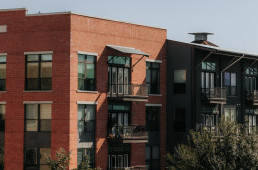
September 22, 2023 | by Michael Wilt
The housing world is full of acronyms, and a recent one is gaining more notoriety in the debate over what kind of housing should be built, how much of it, and where it should be located. That acronym is YIMBY and is defined as "Yes in My Backyard." It has gained traction primarily in urban areas where people feel that the solution to housing affordability lies in simply building more of it.
More broadly, the YIMBY movement is pro-development and "generally supports planning and building at larger scales than the country's history of sprawl, single-family zoning, and car-centric planning has allowed" as Planetizen explains, further adding that "the primary idea behind the YIMBY movement is that land use regulations, such as zoning codes, should be reformed to allow more housing to be built."
By doing so, YIMBYs believe that the market can address housing affordability by offering more options at all income levels with the environmental benefit of reduced sprawl and less traffic.
The term "YIMBY" was created intentionally as a response to "NIMBY" or "Not in My Backyard" which generally describes the desire to protect neighborhoods as they exist and encourage housing development in other parts of a city. While YIMBYs embrace their acronym and use it widely, the term NIMBY often has a negative connotation given its perception of being anti-housing.
At the heart of this housing debate is whether market-driven solutions can help address a city's housing affordability problem. YIMBYs believe that the basic economic principle of increasing housing supply will stabilize demand and thereby reduce rents or home prices.
There's data to support this in a 2021 research paper issued by three economists. Their main finding was that the "supply of new market rate units triggers moving chains that quickly reach middle- and low-income neighborhoods and individuals. Thus, new market-rate construction loosens the housing market in middle- and low-income areas even in the short run. Market-rate supply is likely to improve affordability outside the sub-markets where new construction occurs and to benefit low-income people."
This process is referred to as "filtering," but it's easier to understand as a chain reaction. When a newer, nicer apartment or home is built, someone "upgrades" into that unit and vacates a more affordable one. Then, another resident "upgrades" by moving into the home which was just vacated and by doing so vacates another home that someone can move into. This chain reaction continues, and ultimately, it means that even the addition of high-end units can create more naturally occurring affordable housing down through the housing market.
YIMBYs are largely interested in policies, programs, and incentives that encourage more housing production. As a result, they've supported policies like less restrictive zoning, reduced minimum lot sizes, increased density, faster development permitting processes, less regulatory restrictions on housing development, the increased supply of duplexes, triplexes, quadplexes, and accessory dwelling units which are literally homes in a backyard.
The YIMBY movement includes representation from younger generations who are feeling the pinch of high rental rates and home prices that seem increasingly out of reach for their respective generations. Their ultimate hope is that an abundance of housing at all price levels will allow the market to create housing options for all types of households in areas they reside.
On the House blog posts are meant to provide general information on various housing-related issues, research and programs. We are not liable for any errors or inaccuracies in the information provided by blog sources. Furthermore, this blog is not legal advice and should not be used as a substitute for legal advice from a licensed professional attorney.
TSAHC reviews all blog comments before they are posted to ensure a positive experience for our online community. Off-topic comments; hostile, derogatory or deliberately insulting comments; and comments specifically promoting goods and services will not be posted.
Approved comments will be published in their entirety. Personal information will not be removed unless it pertains to someone other than the person submitting the comment. For more information, please see our Comment Posting Guidelines.
To remove a previously submitted and published comment, please contact Anna Orendain at [email protected].
If you have a question regarding any of TSAHC's programs, please contact us.

Dear Affordability Group,
I have built two houses , remodeled a third, and am appalled at your naivety! If land, construction plans, bridge loans, permits, building materials, labor, etc., are market rate, the final product will be “market rate.’ And, building more, and more, and more market rate dwellings does not produce below market rate housing! Stop this naivety!
For the record, the CA billionaires funding the YIMBY Movement are only interested in removing all building codes and have yet to fund any affordable housing. YIMBY is a phony disingenuous affront to those who need affordable housing! Habitat for Humanity and other deed protected models are available to actually help the situations ... far more than CA billionaires have done!!!
M. L. Johnson, Ed.D., Ph.D.